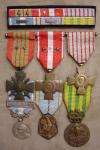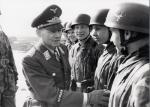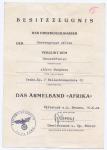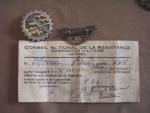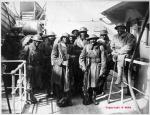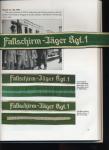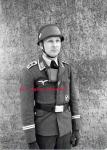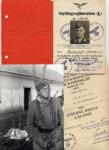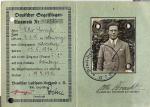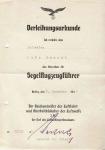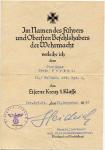-
Posts
2,284 -
Joined
-
Last visited
-
Days Won
6
Content Type
Profiles
Forums
Blogs
Gallery
Events
Store
Everything posted by PKeating
-
A posthumous award to an early casualty, Gaston Blanchard, who was killed in action at the Battle of Rosalies.
-
Unattributable because the houseclearer from whom I got it, with some other items, declined to give me any family names. I have the missing Palm with broken prongs. PK
-
Oh yes...I think that if he shouted at you to get out of bed and on parade in a very cold morning, you would move very fast! One very serious guy! PK
-
Here is another EXTREME ORIENT clasp on a small ?Free French-issue? Colonial Medal, part of a pair with a 1939-1945 War Medal with the clasps FRANCE and ENGAG? VOLONTAIRE. They are in a period frame with a Colonial Medal certificate issued in Saigon in 1947 to Sergent Roger Loncle of the French Air Force?s Compagnie de Garde de l?Air 595. The C.G.A 595 was tasked with securing Tan Son Nhut airport, near Saigon, after the Japanese surrender in August 1946. French armed forces had co-existed uneasily with the Japanese armed forces during their occupation of Indo-China and there would have been a contingent of French guards stationed at Tan Son Nhut. This unit might have been the Compagnie de Police S?curit? Tan Son Nhut. Some sources say that the C.P.S. Tan Son Nhut was redesignated C.G.A 595bis, then C.G.A 595 and, later, C.G.A 31/191. I am inclined to believe that C.G.A 595 was the unit designation of the 150-strong contingent airlifted to Tan Son Nhut in August 1945 and that these men were drawn from Free French Forces in Europe. This might explain the presence of the FRANCE clasp on Loncle?s War Medal. The ENGAG? VOLONTAIRE clasp also points to a Frenchman who volunteered to join General de Gaulle?s forces rather than staying in France. However, perhaps there are some members here who can tell me more than I have so far been able to find out. The document is signed by General Raoul Salan, Commander-in-Chief of French forces in Indo-China in the early stages of the First Indo-China War. Salan would later gain notoriety for his r?le in, amongst other things, the attempted coup d??tat against President de Gaulle in 1961. The rebels took control of Algiers and other major centres but the putsch des g?n?raux, as it is also known, was suppressed before they could carry out their planned airborne assault on central Paris. Along with others, Salan was charged with treason and condemned to death in absentia. On the run, he and others founded the OAS or Organisation de l?Arm?e Secr?te, best-known to those unfamiliar with postwar French history through the opening scenes of Day of the Jackal, when OAS men spray de Gaulle?s Citro?n DS with machinegun fire. Salan was captured in 1962 but his sentence was commuted to life imprisonment. He and other officers were amnestied in 1968 and released. In 1982, their ranks and honours were restored in a move by the socialist Mitterand government that enraged many of France?s committed lefties. However, Mitterand himself had a chequered past, as one of the relatively few Vichy officials awarded the Ordre de la Francisque by P?tain before he reinvented himself as a R?sistance hero. French politics and history are nothing if not complicated? As a sidenote, the 1961 putsch is the reason why there is a 2eme R?giment ?tranger de Parachutistes but no 1 REP. The 1 REP was scheduled to jump on Paris to secure various centres of command and government. According to veterans with whom I have spoken, suggested drop zones included the Bois de Vincennes, which is full of trees and far enough from central Paris to have required an Arnhem-style tab from the DZ, or the Jardins des Tuileries, which is full of spiked railings and other lethal objects or, at any rate, objects likely to terrify descending paratroopers. The Tuileries proposal was apparently accepted and must rank as one of the most harebrained ideas since Otto Skorzeny?s plan for SS-Fallschirmj?ger-Btl 500 to jump on the Citadel in Budapest in 1944. Fortunately for the men of 1 REP, the mission was aborted as the planes werew warming their motors. Anyway?just a piece of history found under a table in the Vanves flea market one cold, dark, wet Sunday morning.
-
Here is an "Extreme Orient" group. Hendrik's superb website gives the following explanation of this clasp: "(5 August 1946) : awarded to those that participated in the fighting against the Japanese (who attacked garrisons and barracks of the French forces in Indochina by surprise on 9 March 1945) between 9 March and 18 September 1945 and against "rebels" from 23 September 1945 onwards. These so-called rebels are in fact the Viet-minh of the Ho Chi Minh government which was installed on 20 August. France would never be able to completely subdue them ... Recipients of this bar were also eligible for the Commemorative Medal for Indochina."
-
This is the kind of document most often encountered to Heeresgruppe Afrika veterans. HG Afrika was formed in Tunisia on 22.2.1943 with German and Italian units from the Deutsch-Italienische Panzerarmee and Organisationsstab Tunesien, under Rommel's command. Rommel handed over to Generaloberst von Arnim on 9.3.1943. Arnim went into the bag as a POW on 12.5.1943 when HG Afrika surrendered, ending the German adventure in North Africa. Fallschirmj?ger-Brigade Ramcke, on the ORBAT of the Deutsch-Italienische Panzerarmee since late 1942, remained on the ORBAT of HG Afrika. So Burghaus probably took part in FB Ramcke's epic 200-mile march to safety after the second Battle of El-Alamein. Ramcke-Brigade ORBAT: Brigadestab I./Fallschirmj?ger-Regiment 2 - Major Kroh I./Fallschirmj?ger-Regiment 3 - Major von der Heydte II./Fallschirmj?ger-Battalion 5 - Major Hubner Fallschirmj?ger-Lehr-Battalion - Major Burckhardt II./Fallschirm-Artillerie-Regiment Pionier-Kompanie - Dr. Cord Tietjen Panzerj?ger-Kompanie After the escape from El-Alamein, the Ramcke Brigade was redesignated Luftwaffen-J?ger-Brigade 1 and was committed against British forces in the southern Tunisian mountains, under the command of Major Hans Kroh, Ramcke having been transferred to France, where the Fallschirm-Armee was being formed. Alfred Burghaus might have served with the Heer's Fallschirm-Infanterie-Bataillon before the war. That said, I do not recall any photos of Fallschirmschule personnel wearing the FSA (Heer). That doesn't mean former Heer paras were not posted to jump schools, just that I am unaware of it. Eric Queen would be the man to ask. Burghaus was a Senior NCO in the Technical Company, which indicates that he might have had something to do with the development of new methods and parachuting equipment: dropping vehicles, the triangular parachutes etc etc... He might have been wounded and evacuated before the end, hence his posting to Wittstock. Or he might previously have been an instructor or had some technical skills deemed vital to the formation and training of the new Fallschirm-Armee. The document is a loner, sadly, another victim of some idiot who broke up a group at some point in the past. Anyway, since I don't have any other AFRIKA documents, being in the process of getting rid of most of my TR stuff, here's a photo of Vater Ramcke himself, wearing another kind of AFRIKA band as he reviews fresh young paratroopers in France after his return from Tunisia. Note the absence of a breast eagle, the tunic clearly being brand new. He shouldn't have been wearing the AFRIKA cuff title in Europe but who was going to point that out to him? PK
-
Hallo Bill! The staff officer who signed this document on behalf of Ke?elring was a Major Pfeffer. As you say, his signature appears on quite a few documents. By the time this document was actually awarded, the title of Oberbefehlshaber S?d had been changed to Oberbefehlshaber S?dwest. It is not terribly common to see this early type with such a late award date. Below is another type, issued in the summer of 1944. PK
-
Merci, cher ami. Voil?! On apprend quelque chose de nouveau tous les jours! So, in brutal Anglo-Saxon parlance, it is in fact "bling". To be honest, I think that it should be made an official award. PK
-
I think the Bless?s medal relates to the 1914-1918 medals, which would make it an official award, no? The M?daille de la R?sistance is his only 1939-1945 award and he wears the miniature lapel badge of the FFI combatants' badge, a numbered silver award given to resistance veterans with a matching certificate.
-

EK 1914 Document - EK1 to Jew
PKeating replied to Igor Ostapenko's topic in Germany: All Eras: The Iron Cross
Brainus has contributed all sorts of fascinating details of the von Etzel family's history to the internet. Did you know that one of the family also won a Knight's Cross at Stalingrad before dying there? I wish he would write a book about it. PK -
Very true. Well said! Here is a wonderful shot from NARA of members of the 369?me RIUS aka The Old Fifteenth, The Black Rattlers and the Harlem Hell Fighters just before disembarkation in New York City in 1919. This is just a low resolution file for the forum. You don't often see this kind of ambience in photographs of this period. Some of the stuff in the files is just breathtaking, especially the colour images, by which I mean colour rather than colorized photographs. You can be pretty sure that these boys didn't get that German helmet in a game of cards far behind the lines... PK
-
Gerry Embleton and I are very happy to have been able to contribute to this great website by Chris Boonzaier and Gordon Williamson. Gerry's fine artwork should be well-known to anyone with a reasonably-sized library of military history books by Osprey and other publishers. He and his team also work with various museums and have contributed to many exhibitions around the world, including one at the Smithsonian Institute on the French and Indian War, also known variously as The Seven Years War, amongst other things. I have collaborated with Gerry on several major articles, including this one on the Harlem Hellfighters, an overview of The Seven Years War focusing on three major engagements in North America, the Berezina FUBAR, Landesknecht and, coming shortly, an account of Tul Bahadur Pun VC's heroism and HM Government's moral cowardice. Check his website out: http://www.gerryembleton.com/ I haven't redone my website yet but all of these features will be there, alongside the reportage and the fashion and style stuff. I'd like to thank Ulsterman for his comments. It is nice, of course, when people like what one does, and I thank you for the kind words, but I am always very interested in proper criticism and I would like to respond to your observation as I know that quite a few people, when the article was originally published, found my closing lines a bit harsh if not offensive. I wrote: You speak for some of these readers with the following remark: I did make reasonable efforts to get a comment from the US Department of Defense but they never responded and I eventually ran up against the deadline. I think I phrased my closing lines fairly carefully. While I would not tar those involved in the 1996/97 and 2002/03 decision-making processes in relation to Henry Johnson and the CMoH as racists per se, I would say that they and their superiors were certainly guilty of racism by association or, at least, aiding and abetting racism. I am sure that this conclusion is offensive to some people but naked truth rarely gives people the warm and fuzzies. I would qualify this by saying that the naked truth in question is, of course, the naked truth as I - and many other people - see it. If the CMoH Review Board member who belongs to GMIC wishes to comment, I would of course be very interested in anything he has to say. I understand that he might not wish to get into a bunfight on an internet forum. However, if he wishes to show my article to the board in question and they wish to comment for the purposes of inclusion in any future publications of the article, I will be very pleased to hear from them and to give them a voice in the narrative. I have written most of a screenplay about the Harlem Hellfighters and I was recently approached by one of France's leading documentary makers about collaborating on a new documentary about the regiment. If that happens, I expect we would wish to interview relevant people in the Department of Defense hierarchy in relation to Henry Johnson. Now, let's examine the facts as they are. When the Clinton administration undertook a review of African-Americans denied the CMoH in 1996, the focus was on World War Two. Ten candidates were proposed to the CMoH Review Board in 1996, which chose seven of them, only one of whom was still alive. The seven awards were for World War Two. There was, predictably, a negative reaction from some quarters to the retrospective CMoH awards from conservative types. While some critics, doubtless, simply objected to retrospective awards in principle, it is pretty clear that many objections were rooted in racist sentiment, as well as a seething hatred of Clinton that resulted in automatic criticism of anything he did or tried to do. Had there been equal focus upon World War One, Henry Johnson - and others - might have been granted posthumous Congressional Medals of Honor. However, representations were certainly made to the DoD on behalf of Henry Johnson at the time because he was granted a posthumous Purple Heart in 1997. The facts are straightforward. It is an indisputable fact that Henry Johnson - and other men of colour - were denied the CMoH during The Great War for no reason other than the colour of the skin. This attitude to black soldiers on the part of the US military establishment in the first half of the twentieth century was even more perverse when one considers that black soldiers had been awarded the CMoH during previous conflicts like the War of Secession and the Indian Wars. So Henry Johnson was denied a CMoH in 1918 because he was black. Johnson was also denied a DSC at the time. That is a matter of record. His regimental commander's promotion of Johnson from Private straight to Sergeant was an attempt to make up for this. Yet, for all that, Johnson was recognised as one of the war's foremost heroes, even being received by the President of the United States of America after the regiment's return from Europe. On top of that, the Department of Defense has even had the brass neck to exploit Henry Johnson's likeness on various occasions in the intervening years to raise money and for recruiting campaigns aimed at ethnic minorities. And in 1929, as I mentioned in the article, parties so far unknown arranged for his interment in Arlington. So there was no question about Henry Johnson's extraordinary heroism at the time or in the intervening decades. During The Great War, the US military establishment fobbed black heroes off with the DSC instead of giving them the CMoH. This comment is not intended to denigrate the DSC in any way. It is, after all, the United States' second-highest award for bravery in the field. In a sense, the US military dishonoured the DSC by using it as an alternative to the CMoH for Jim Crow. In 2003, after further representations in 2002, the US military establishment, under some pressure, finally recognised Henry Johnson's heroism with a posthumous DSC. In other words, just like their forebears eighty-five years before, they fobbed a black hero off with a DSC instead of a CMoH. It really is as simple as that, no matter how you try to dress it up. That was the point I was making at the end of the article, albeit discreetly because I hesitated to accuse the current decision-makers of racism. However, they - and anyone influencing or approving of their decisions in this case - were certainly guilty in 2002 of aiding and abetting the perpetuation eighty-four years after the fact of a disgusting injustice rooted firmly in the official racism prevalent in 1918. I will reiterate that while I would not tar those involved in the 1996/97 and 2002/03 decision-making processes in relation to Henry Johnson and the CMoH as racists per se, I would say that they and their superiors, all the way up to the top, were certainly guilty of racism by association or, at least, aiding and abetting racism. I am sure that this conclusion is offensive to some people but naked truth will always upset some of those involved and some observers. To summarise, the late Sgt Henry Johnson did not receive the CMoH because he was black and he still has not received it, even though seven African-American heroes of World War Two were retrospectively awarded the CMoH in 1997. Given a chance to rectify this at the time, the Clinton administration gave Johnson a posthumous Purple Heart. Big deal! When the issue was raised again in 2002, the Bush administration - which never had a good relationship with African-Americans in general - did precisely as the US government had done during The Great War and gave Sambo a DSC instead of a CMoH. How in the Hell anyone can interpret this sordid scenario as anything but an objectionable perpetuation of the whole Jim Crow thing baffles me. The solution is really quite simple: they should cease prevaricating forthwith and put it right by upgrading Sgt Johnson's posthumous DSC to a CMoH. PK
-

Luftwaffe FJR cuff titles
PKeating replied to Eric Stahlhut's topic in Wehrmacht Medals, Decorations & Awards
-

Luftwaffe FJR cuff titles
PKeating replied to Eric Stahlhut's topic in Wehrmacht Medals, Decorations & Awards
-

Luftwaffe FJR cuff titles
PKeating replied to Eric Stahlhut's topic in Wehrmacht Medals, Decorations & Awards
Sorry guys. I only just saw this thread. I concur with heinrich66. The FJR1 cuff title is trying to be like this original example. The FJR2 version is clearly from the same source. Close...but no banana. -
The photograph I found in the French ECPA-D archives at Fort d?Ivry of Otto Bracht in combat kit was from a roll of film shot by Gremelsbacher in the Ukraine sometime during the winter of 1943/44. 2. Fallschirmj?ger-Division had been transferred from Italy to the southern sector of the Eastern Front in November 1943. To be more precise, some elements of 2. FJD had been transferred to Shitomir, the rest being sent off as cadre for the newly-forming 4. FJD. The heavily understrength division, comprising I./FJR2, III./FJR2, IV./FJR2, II./FJR5 and some supporting arms, fought at Shitomir and then at Kirovograd in January 1944. Retreating through Krioj Rog, Uman, Novgorodka and Kiev, April 1944 found the remnants of 2. FJD in the Kishinev zone, from where they were moved back to Germany for R&R and thence to Western France, ending up eventually in Brest with Ramcke. Here is the photo in question, along with Bracht's Military Glider Pilot Licence (very rare document) and the EK2 document. So, as much as I would dearly love this EK2 document to have been for the raid on Drvar, I am more inclined to believe it to have been awarded for combat on the ground during the withdrawal through the Ukraine with 2. FJD. That said, it could have been for Drvar. But as Herr Bracht is dead and nobody in the family can tell me if he was ever in the Balkans, I have run up against the proverbial brick wall on that one. The only hope is to study more SS-KB photos of the LW glider pilots on the ground during the battle on May 25/26 1944 in the hope of spotting a shy-looking chap in spectacles! I haven't seen him in any of the photos I've looked at yet. So, there are two possibilities: Bracht?s EK2 could have been for something he did when on the ground with 2. FJD in the southern USSR after airlanding reinforcements or supplies, perhaps during the Battle of Kirovograd, or it could have been for the Battle of Drvar on 25/26.5.1944. The OKW issued their Drvar communiqu? on 6.6.1944 and awards were made for Drvar on and around that date. If seconded to pilot a DFS 230 into Drvar, Bracht would have come from Hagenau and would have been back there by the evening of 26.5.1944 or the following day and from there to Istres when news of the Allied landings broke. Although LLG2 was primarily equipped with the huge Gotha 242 gliders, they also flew DFS 230s and Bracht would have been DFS 230-qualified. As far as I know, glider pilots and other attached personnel were evacuated from Drvar shortly after the end of the battle on the morning of 26.5.1944. So his EK2 might have been for Drvar but issued by the FS-AOK in Nancy, on 6.6.1944 along with other awards. The Luftwaffe awardee lists would have been telegrammed or telexed to local Luftwaffe headquarters so it would make sense, especially as it is handsigned by Lackner. However, I tend to think Bracht's EK2 was for actions in southern Russia with 2. FJD. Drvar seems too good to be true, which means it probably is too good to be true. Anyway, I hope this little digression will prove useful to anyone considering the collection and study of award documents. It sometimes involves a lot of study, detective work, analysis and no small amount of luck. But it can be very rewarding.
-
And then, whilst researching Luftwaffe KB images held in the French military archives in Paris (ECPAD) for a book that never was, I came across a photo of Bracht, taken by the man reposing under this grave marker in the Ukraine. Ufz und Kriegsberichter Eugen Gremelbacher of the Fallschirm-Propaganda-Kompanie (Now, there's an obscure unit for you, Paul!) was KIA on 8.3.1944. PK
-
Sometimes you get lucky because the family is still alive and can give you some details, or the WASt chooses to be forthcoming, but in the main, working out the story behind German award documents is a process of informed guesswork involving close study and research of the man's unit(s) and an appreciation of how long it might take for a given award to be approved. With the document below, to Otto Bracht of the 2nd Airlanding Squadron, it would have been hard were the document found by itself. Handsigned by Generalleutnant Walter Lackner, in charge of the Fallschirm-Armee-Oberkommando in the southern French town of Nancy, the document presents several possibilities. Dated 6.6.1944, a link with the Normandy Landings is clearly ruled out. In any case, there would have been no reason for Otto Bracht to be anywhere near Normandy, even if the German administrative machine were fast enough to get his document processed the same day! At the time, 3./LLG2 were flying Heinkel IIIs and Go242 gliders and had been based with the rest of the Gruppe at Hagenau in Germany from September 1943 to June 1944, when they moved to Nancy. Prior to that, they had been in Istres, in southern France, and had participated in the Sicily airlifts in July 1943, flying out of Naples and other airfields in Catania. Eleven months would be a tad long for Bracht's EK2 to come through. It occurred to me that the Germans had been obliged to make quite an effort to find pilots and aircraft for the raid on Tito's headquarters at Drvar in May 1944 and that they might have taken pilots like Bracht from units in reserve or training in Germany and France. Moreover, having seen other Drvar award documents dated 6.6.1944, it was a possible fit, even though one might have expected such an award to come through the headquarters running the Tito operation rather than the FSAOK. PK
-
Erwin Forkel received the EK1 for the Sicily campaign whilst serving as an Oberj?ger with 10./Fallschirm-Artillierie-Rgt 1. This document is shown on Page 93 of Bender?s The IRON CROSS of 1939 by Gordon Williamson and is just about to wing its way to Daniele Tirelli, who bought the Forkel group from me to reunite it with Erwin Forkel's photograph album, a rare victory against the group-splitters. The document bears a facsimile Heidrich signature. PK






